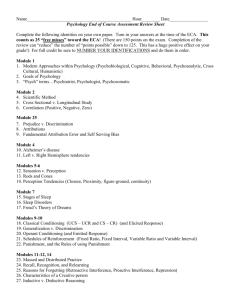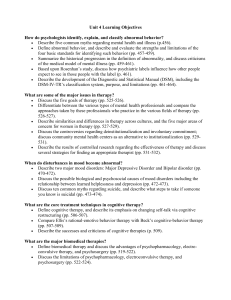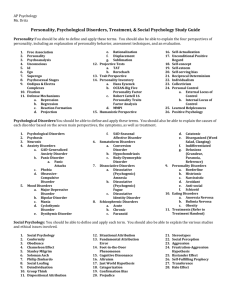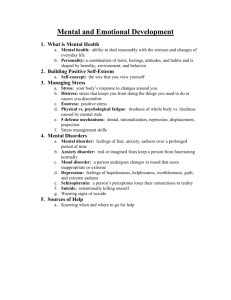Final Exam study-guide for PY 101 2010
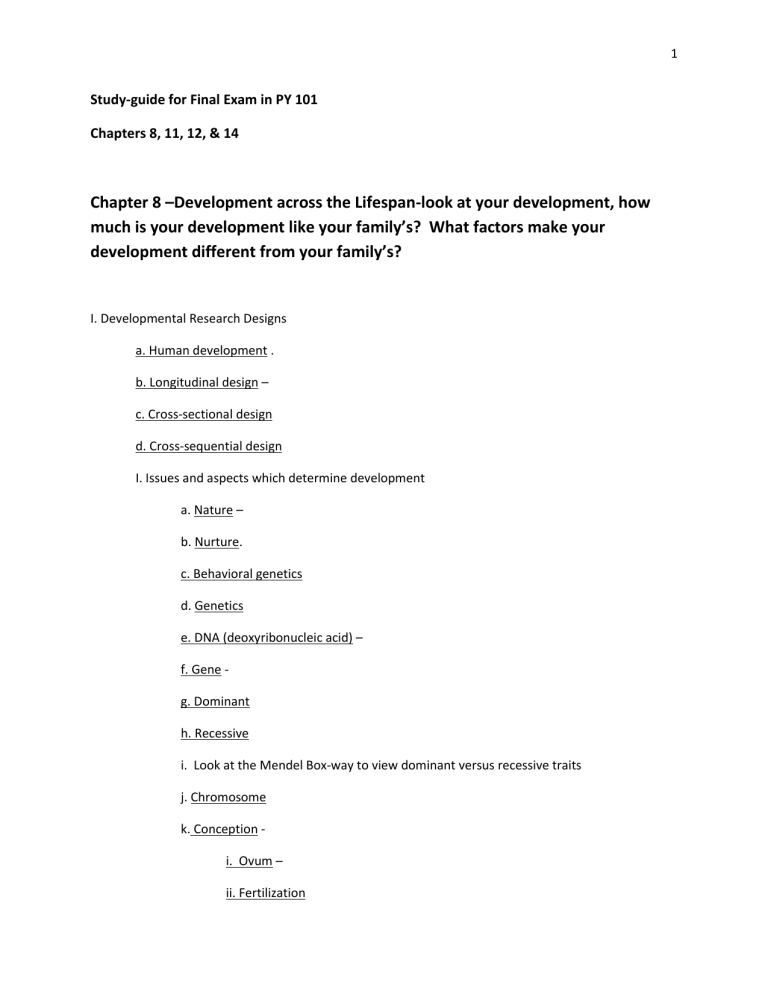
Study-guide for Final Exam in PY 101
Chapters 8, 11, 12, & 14
Chapter 8 –Development across the Lifespan-look at your development, how much is your development like your family’s? What factors make your development different from your family’s?
I. Developmental Research Designs a. Human development . b. Longitudinal design – c. Cross-sectional design d. Cross-sequential design
I. Issues and aspects which determine development a. Nature – b. Nurture. c. Behavioral genetics d. Genetics e. DNA (deoxyribonucleic acid) – f. Gene - g. Dominant h. Recessive i. Look at the Mendel Box-way to view dominant versus recessive traits j. Chromosome k. Conception - i. Ovum – ii. Fertilization
1
• iii. Zygote –
Iv. Monozygotic twins – v. Dizygotic twins – l. Periods of Pregnancy i. Germinal period . ii. Embryonic period – iii. Critical periods –
1. Teratogen -.
2. Fetal period –
3. Fetus - name
II. Physical Development in Infancy and Childhood a. newborns and infants-describe some characteristics
III. Cognitive Development a. Piaget’s Stage Theory-remember the importance of Piaget is that cognition develops in steps and that our thinking improves during these steps. We are not born thinking like adults. i. Sensorimotor stage –
1. Object permanence – ii. Preoperational stage –
1. Egocentrism - the
2. Centration
3. Conservation
4. Irreversibility
Iii. Concrete operations stage
Iv. Formal operations - b. Vygotsky’s Theory-your professor loves Vygotsky
2
3 i. Scaffolding - process in which a more skilled learner gives help to a less skilled learner, reducing the amount of help as the less skilled learner becomes more capable. ii. Zone of proximal development (ZPD) - Vygotsky’s concept of the difference between what a child can do alone and what that child can do with the help of a teacher. c. Stages of Language Development-all children in the world develop language the same way
1. Cooing
2. Babbling
3. One-word speech (holophrases)
4. Telegraphic speech d. Temperament i. Easy - ii. Difficult – iii. Slow to warm up e. Attachment -
• i. Secure -
• Ii. Avoidant –
• Iii.Ambivalent -
• Iv. Disorganized-disoriented –
• f. Erikson’s First Four Stages
• i. Trust versus mistrust -
• Autonomy versus shame and doubt
• Initiative versus guilt -
• Industry versus inferiority –
•
g. Gender Role Development
• Sex-
• Gender-
• Gender identity – h. Puberty and Adolescence
• Adolescence -
• Puberty – i. Flaws in Thinking
• Egocentric Thinking
• Personal fable -
• Imaginary audience –
•
• k. Development of Morality
• Preconventional morality -
• Conventional morality -
• l. Erikson’s Fifth Stage
• Identity versus role confusion –
•
• l. Physical Changes and Aging
• climacteric, ending at about age 50 with
• menopause -
4
• Andropause –
• m. Theories of Aging
• Activity theory -
• Cellular clock theory
• Wear-and-tear theory -
• Free radical theory - o . Stages of Death and Dying
1.
Denial
2.
Anger
3.
Bargaining
4.
Depression
5.
Acceptance
Chapter 11. Stress-how much does stress affect your life, how much do you think it interferes with your daily tasks?
I. Stress – a. What is Stress? i. Stressors ii. Distress iii. Eustress –
5
b. Cognitive Factors of Stress
i. Cognitive appraisal approach - ii. Primary appraisal iii.Secondary appraisal c
. Causes of Stress
• i. Catastrophe -
• ii. Post-Traumatic Stress Disorder (PTSD)
•
• Iii. Major Life Events
• Social Readjustment Rating Scale (SRRS) – this was assignment
•
• College Undergraduate Stress Scale (CUSS) -
• Hassles -
•
• Pressure -
• Uncontrollability – We as Americans really value control!
• Frustration -
• Conflict -
• Pressure -
• Uncontrollability -
• Frustration -
• Aggression -
• Displaced aggression –
• Escape or withdrawal -
6
• Conflict
d. Suicide-this is very important!!!! e.
Types of Conflict
• Approach–approach conflict
• Avoidance–avoidance conflict -
• Approach–avoidance conflict -
• Double approach–avoidance conflict -
• Multiple approach–avoidance conflict
•
f. Bodily Reactions to Stress
Autonomic nervous system
Sympathetic system -
Parasympathetic system –
General Adaptation Syndrome (GAS)
g. Stress and the Immune System
• Immune system
• Psychoneuroimmunology -
• Natural killer cell
h. Stress and Personality
• Type A personality
• Type B personality -
• Type C personality -
• Hardy personality -
• Optimists -
• Pessimists -
7
i. Stress and Social Factors
• Burnout -
• Acculturative stress -
• Four Methods of Acculturation:
Integration
Assimilation
Separation
Marginalization
j. Social support system j.
Ways to Deal with Stress
• Coping strategies -
• Problem-focused coping-
• Emotion-focused coping -
k. Defense Mechanisms-professor really loves these!
• Psychological defense mechanisms
• Denial -
• Repression -
• Rationalization
• Projection
• Reaction formation
• Displacement -
• Regression
• Identification -
• Compensation (substitution)
• Sublimation –
8
III. Ways to alleviate Stress-healthy ways
a. Meditation i. Concentrative meditation - ii. Receptive meditation -
b Cultural Influences on Stress c.
Factors Promoting Wellness
• Exercise
• Social activities
• Getting enough sleep
• Eating healthy foods
• Having fun
• Managing one’s time
• Practicing good coping skills
Chapter 12 Social Psychology-how much do others influence your behavior? How much are you an individual?
I. Social Psychology a. Social psychology – b. Social influence - c. Conformity - d. Groupthink - e. Consumer psychology .
9
10
II. Compliance - a. Four Ways to Gain Compliance i. Foot-in-the-door technique ii.Door-in-the-face technique –
1. Norm of reciprocity – iii. Lowball technique – iv. That’s-not-all technique -
III. Obedience a. Obedience - i. Milgram study – “teacher” administered what they thought were real shocks to a “learner. b. Social Loafing and Social Facilitation i. Social facilitation - ii. Social loafing – c.Attitude - a tendency to respond positively or negatively toward a certain person, object, idea, or situation. i. The three components of an attitude- ii. Formation of Attitudes
d. Persuasion –
Elaboration likelihood model –
Central-route processing -
Peripheral-route processing - e. Cognitive dissonance – f. Social cognition -
Impression formation -
Primacy effect – g. Social categorizations
Stereotype -
Implicit personality theory -
Schemas – h. Attributions
Fundamental attribution error (actor-observer bias) i.Prejudice and Discrimination
Prejudice -
Discrimination -
In-groups -
Out-groups -
Realistic conflict theory -
11
Scapegoating - j. Stopping Prejudice
Social cognitive theory –
Social identity theory –
Social identity -
Social comparison –
Stereotype vulnerability -
Self-fulfilling prophecy -
Equal status contact -
“Jigsaw classroom” - k. Attraction
Interpersonal attraction -
Proximity -
Reciprocity of liking -
Love -
Sternberg
Romantic love -
Companionate love - l.Aggression
Aggression
Biological influences
Social role -
Violent TV, movies, and videos are related to aggression.
Altruism
12
m.Prosocial behavior - socially desirable behavior that benefits others.
Altruism – n. Bystander Effect
Diffusion of responsibility –
Latané and Darley
One bystander cannot diffuse responsibility. o. Five Steps in Making a Decision to Help
Noticing
Defining an emergency
Taking responsibility
Planning a course of action
Taking action p. Cults
Chapter 14 Psychological Disorders-what is abnormal? What is normal behavior? Is there such a thing as normal behavior?
I. Definitions of Abnormality a. Psychopathology -
13
• b. Psychological disorders -
• c. Definitions of Abnormality:
Statistically rare
Deviant from social norms
Situational context -
Subjective discomfort
Maladaptive – d. Biology and Psychopathology
Biological model –in the beginning of the semester we discussed this.
Psychoanalytic theorists -
Behaviorists -
Cognitive theorists -. f. Culture and Psychopathology
Cultural relativity -
Culture-bound syndromes –. g. Types of Disorders i. Major depression ii. Anxiety disorders -
Free-floating anxiety -
Phobia -
Social phobia -
Specific phobia -
Claustrophobia -
Acrophobia -
14
Agoraphobia -
Panic disorder –
Panic attack –
Obsessive-compulsive disorder -MONK
Panic disorder with agoraphobia -
Generalized anxiety disorder - iii. Causes of Anxiety Disorders
Psychoanalytic
Behaviorists
Cognitive psychologists
Magnification -
All-or-nothing thinking -
Overgeneralization -
Minimization -
Biological explanations h. Dissociative disorders –
Dissociative amnesia -
Dissociative fugue -
Dissociative identity disorder -
Depersonalization disorder – i. Development of Dissociative Disorders
Psychoanalytic
Cognitive and behavioral
Biological
15
Sybil Controversy j. Mood Disorders
Affect –
Mood disorders -
Dysthymia -
Cyclothymia -
Major depression -
Manic -
Bipolar disorder – k. Causes of Mood Disorders
Psychoanalytic
Learning
Cognitive
Biological l. Schizophrenia -
Psychotic -
Positive symptoms –
Delusions –
Delusional disorder).
Hallucinations –
Negative symptoms -
Flat affect - m. Types of Schizophrenia
Disorganized -
16
Catatonic -
Paranoid - t
Undifferentiated -
Residual - n. Causes of Schizophrenia
Psychoanalytic
Behaviorists.
Cognitive
Biological
Stress-vulnerability model - o. Personality disorders -
Antisocial personality disorder -
Borderline personality disorder – p. Causes of Personality Disorders
Psychoanalysts
Cognitive-learning
Biological
Other possible causes
17


